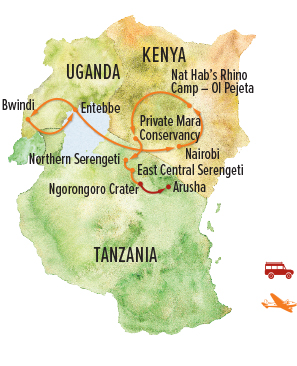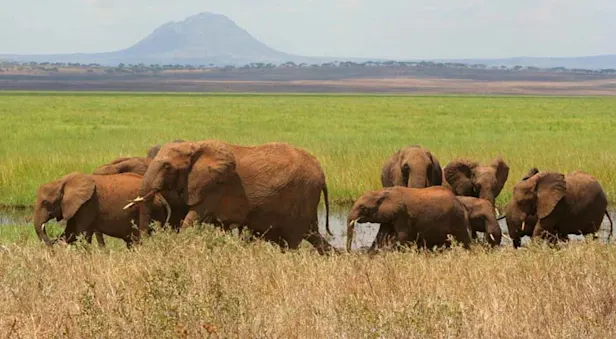Itinerary
Upon your arrival in Entebbe, our Expedition Leader meets you at the airport. Transfer to our boutique hotel, a refuge set amid lush gardens in this peaceful city that was the capital of Uganda during colonial times. This evening, enjoy a welcome dinner with traveling companions and our expert naturalist guide who is with you throughout your entire journey.
Day 2: Entebbe / Bwindi Impenetrable National Park
Fly from Entebbe to Kihihi and transfer to our rainforest ecolodge on the edge of Bwindi Impenetrable National Park. This UNESCO World Heritage Site is one of the world's most famous destinations for gorilla trekking. Bwindi is home to nearly half the world’s mountain gorillas—about 460—a population that is growing but still threatened by increasing human presence in the surrounding communities. We may even catch our first glimpse of mountain gorillas right on the grounds of the lodge, since many trails into the park's dense jungle, which early explorers called the “Impenetrable Forest,” leave directly from here. Responsible tourism has been integral to sustaining critically endangered gorillas, and the dollars we infuse into the local community help support their protection by sustaining the people who live near them.
Days 3 & 4: Gorilla Trekking in Bwindi Impenetrable Forest
Spend two full days tracking gorillas in Bwindi Impenetrable National Park. Rise early each morning in anticipation of a peerless experience: the chance to look into the face of a wild gorilla. After an early breakfast, make a short drive to park headquarters to meet our local guides who provide an orientation to the day's trek, covering the etiquette of behavior among the gorillas. From here, we walk or drive a short distance to the trek starting point, then head into the emerald rainforest on foot, accompanied by local guides.
The trackers are out on the mountain ahead of our departure, identifying where the gorillas were seen the night before and pursuing them to a point where we are able to connect. Reaching the gorillas' current location can take as little as 15 minutes or up to several hours, depending on how far the gorilla family has traveled. The trek may involve climbing to altitudes above 7,500 feet over terrain is rough and at times muddy, though the rewards are profound. While the hike can be physically demanding, the beauty of the forest en route makes it worthwhile. Once we find the gorillas, all fatigue is forgotten, and the experience is often described as the most profound nature encounter travelers have ever experienced. If time permits, we’ll visit Conservation Coffee, a local co-op of farmers who grow, process and roast beans to sell at a premium to benefit gorilla conservation. We may have a chance to walk through the coffee fields, pick some beans, and witness this sustainable community enterprise firsthand.
Day 5: Kihihi / Entebbe / Nairobi, Kenya
Fly from Kihihi back to Entebbe this morning to connect with our flight to Kenya's capital of Nairobi. From the airport, transfer to the House of Waine, located in the quiet residential suburb of Karen on the outskirts of the city. Originally built as a lavish private estate, today the stately home surrounded by lush gardens is one of Nairobi's most elegant boutique hotels. It sits at the foot of the Ngong Hills, an area made famous in Isak Dinesen's well-known memoir Out of Africa.
Days 6–8: Ol Pejeta Conservancy—Nat Hab's Rhino Camp

Fly north to the renowned Ol Pejeta Conservancy, located on the Laikipia Plateau in the shadow of Mount Kenya. A working cattle ranch established in the 1940s during Kenya's colonial days, Ol Pejeta set aside land for rhino conservation in 1988 and has become a trailblazer for conservation innovation. Today it is the largest black rhino sanctuary in East Africa and home to the world’s last two remaining northern white rhinos, a staunchly guarded pair of females, which we visit in person. The conservancy is also home to the endangered Grevy's zebra and has some of Kenya's highest predator densities, yet still manages a very successful livestock program. Ol Pejeta seeks to preserve the exceptional biodiversity within its 90,000 acres while supporting the people living on its borders, to ensure that wildlife conservation translates to better education, healthcare and infrastructure for the next generation of wildlife guardians. In 2014, Ol Pejeta achieved IUCN Green List status, one of only two conservancies in Africa to be so recognized. The Green List aims to define excellence in managing valuable natural areas.
Nat Hab's Rhino Camp inside the conservancy is the ideal base from which to explore this diverse wildlife haven that contains many of Kenya's endemic northern species. We'll hope to see the legendary Big Five and more on day and night safari drives and guided walks set against the backdrop of snowcapped Mount Kenya. At the end of each exhilarating foray into the bush, return to the comforts of our tented camp, redolent with the ambience of East Africa's classic safari era.
Days 9 & 10: Private Mara Conservancy—Nat Hab's Mara East Camp
Fly this morning to the Maasai Mara, one of Africa’s most legendary wildlife realms. Secluded within a vast private conservancy that borders the Maasai Mara National Reserve, our isolated tented camp is surrounded by all the wonders of the Mara ecosystem without the crowds. The conservancy offers the rare opportunity to experience the Mara’s spectacular wildlife in peaceful seclusion, and our deluxe camp is one of just a handful located within its bounds. Strict limits on guest numbers means unprecedented wildlife viewing largely in solitude, especially of the wildebeest migration that occurs in close proximity.
The conservancy serves as a migration corridor for thousands of animals moving between the Maasai Mara National Reserve and the Loita Plains to the east. Herds of antelope dot the rolling plains while acacia trees shelter prolific birdlife. Rich volcanic soils nurture the savanna where we find more lions per square mile than anywhere else in Kenya. Large herds of elephant, giraffe and zebra are also on view. Our activities make the most of our unrivaled access to this wide-open wild land. In addition to daily game drives, enjoy guided bush walks, wilderness picnics, off-road safaris and night drives in search of nocturnal wildlife—exciting activities not permitted in the adjacent national reserve.
Days 11–13: Northern Serengeti, Tanzania—Nat Hab’s Migration Camp
Fly on to the Serengeti Plains, the Tanzanian side of the massive Mara-Serengeti ecosystem. The sweeping sea of grass that comprises Serengeti National Park is roughly the size of Maryland, and its reputation as one of the world’s iconic nature destinations is well deserved. Staggering concentrations of hoofed game and prodigious predators engage in an ancient and epic struggle for survival. Nat Hab's private mobile camp provides a front-row view on all the action, as well as the romance of sleeping under canvas beneath starry African skies.
We spend three days in the remote northern reaches of the Serengeti, immersed in the phenomenon of the Great Migration. In accord with the animals' movement patterns, our mobile camp is placed in a main migration corridor traversed by more than 2 million wildebeest, zebra and gazelle, plus an accompanying cast of predators, on their annual 1,800-mile trek from Kenya’s Maasai Mara to the southern Serengeti and back again. Witness this remarkable spectacle on daily game drives, where we may behold stunning scenes of predator-prey interaction as a lion takes down a sick wildebeest or a cheetah overtakes an infant antelope. We track the herds in private 4x4 vehicles, allowing for optimal mobility and proximity. We also have the option of a sunrise hot air balloon safari ride (additional cost). Our luxury mobile camp ensures that we go where the wildlife is, yet it offers surprising comfort given the remoteness of our location. Walk-in canvas tents are reminiscent of the safari era of yesteryear, offering vintage ambience. Each evening, dine under a canopy of stars and share impressions of the day around a crackling campfire.
Days 14 & 15: East-Central Serengeti — Nat Hab’s Serengeti East Camp
Fly to the eastern Serengeti today for a two-night stay at our own exclusive bush camp, brand-new in 2023. Surrounded by open range and kopjes—large granite outcrops that dot the plains—our private camp offers fabulous wildlife viewing in diverse habitats, particularly of the abundant feline predators that live and hunt in this area. It also provides exceptional seclusion away from crowds. From canvas tents shaded by giant acacia trees, survey 360-degree views of wildlife traversing the savanna, with more thrilling encounters in store on game drives.
The surrounding environs are dotted with dramatic rocky outcrops, and the sunrise over these granite kopjes is glorious. Shaded by giant acacias, our camp lies where the short-grass plains meet acacia woodlands. The nearby Nyabogati River sustains year-round wildlife concentrations. From this secluded outpost we can expect unrivaled sightings of the big cats that are so plentiful in this area. Until recently, this area was set aside for scientific research into predators, especially cheetah, but today, we are able to enjoy that same access to this dense feline population. Such close encounters with the Serengeti’s apex predators are sure to enthrall even the most seasoned safari traveler.
Day 16: Serengeti / Ngorongoro Highlands
Make a last Serengeti game drive this morning en route to the airstrip where we meet our flight to Karatu. Upon landing, we make an easy drive into the lush Ngorongoro Highlands, a verdant expanse of wild bush and agricultural land comprising the heart of Tanzania's coffee country. This afternoon, arrive at our elegant lodge where you may wish to take an optional tour of a coffee plantation—this is prime terrain for growing some of Africa’s finest beans in the moisture-laden, high-altitude cloud forest environs. Or, choose to relax in the lush garden setting of our lodge, perhaps enjoying a swim or a massage before dinner.
Day 17: Ngorongoro Crater Safari
Leave very early this morning for one of Africa’s consummate safari experiences: a journey into the massive caldera that is the Ngorongoro Crater. We climb to the rim, then drop down the steep wall to the 100-square-mile crater floor. One of the Seven Natural Wonders of Africa, Ngorongoro Crater is the largest unbroken caldera on Earth—the center of a huge ancient volcano that scientists believe may have been larger than Mount Kilimanjaro. Twelve miles across and 2,000 feet deep, the crater is home to some 30,000 animals that live year-round inside its walls, attracted to its perpetual water sources.
Here in this veritable Eden, a wide variety of wildlife thrives within an ecosystem of abundant resources. Along with many mammals, flocks of pink flamingos cover the soda lakes, while large land birds like ostrich and kory bustard roam the grassy plain. Because of the crater's permanent supply of fresh water, it sustains the densest concentration of wildlife in Africa. Common sightings include elephant, buffalo, hippo, giraffe, zebra, blue wildebeest, eland, gazelle and waterbuck, while lion and hyena are abundant predators. A glimpse of the rare black rhinoceros is a special prize. Late this afternoon, we exit the crater and return to our lodge.
Day 18: School Visit / Arusha / Depart
This morning we make the easy drive back to Arusha on a tarmac road, passing farms, villages and lively roadside markets en route. In Karatu, we stop at a local primary school supported by Nat Hab’s philanthropy program, where we meet the children and learn about how our tourism dollars contribute to their education, making a tremendous difference to the economically challenged students who attend here. Continue to Arusha, arriving at Ngare Sero Lodge at the base of Mount Meru, where a farewell lunch is served on arrival. Day rooms await in this peaceful setting, offering a chance to relax and refresh before your transfer to Kilimanjaro Airport for international departures this evening.



























